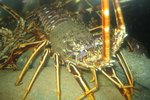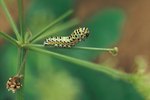
Many bugs you see invading your yard get there by using their legs, but a few survive without the benefit of appendages. All bugs classified as true insects have legs as adults, but many true insect babies, or larvae, don't have legs until they metamorphose into adults. Some other creatures that aren't true insects but are bugs to many of us never develop legs, while so-called bugs such as spiders and centipedes have legs from the moment they hatch from eggs.
Insect Life Cycle
Most insects follow similar life patterns, although the details of each species' life cycle often differ. They start out as eggs, then hatch into larvae of some kind. The larvae grow into adults, some by changing through several instars and others by growing into pupae that metamorphose into adults. Regardless of the details of specific life cycles, many of the larvae survive without legs, often looking like small worms.
Legless Insect Larvae
Many types of larvae don't have legs. Fly maggots, for example, look like tiny, white worms that invade areas with animal feces or decaying flesh and your outdoor trash can. Mosquito larvae have neither wings nor legs, surviving in aquatic environments. Grubs, such as the larvae of weevils, look like fat worms with no legs and live in the top layer of soil. Gnat larvae are called midges; they are small and thin, and they live in water or in damp organic matter such as fallen leaves.
Some Have Legs
Some insect larvae rely on legs to help them find meals and safe places to avoid predators. Butterflies and moths are caterpillars as larvae. These don't have the same legs as adults, but they have small, fleshy prolegs that aren't segmented and that disappear after metamorphosis. Many beetle larvae, such as those of ladybugs, tend to have legs to help them catch other insects as prey.
Other Creepy Crawlies With No Legs
Although not technically insects, similar creatures exist that share habitats with insects but don't have legs -- though they're often thought of as bugs, they're not categorized as insects, in part because, as adults, they move without the use of appendages. Earthworms, for example, contract and release muscles in segments along their bodies to burrow through soil. Snails and slugs are technically mollusks, but they share habitats with many insects. They move through large muscle contractions along singular "feet" that extend along the bases of their bodies.
References
- Texas A&M AgriLife Extension: Overview of Insect Orders
- University of Kentucky: Recognizing Insect Larval Types
- Mobile Journal: Larvae Are Not Worms
- fintrac / US Aid: Integrated Pest Management –- Types of Insect Larvae
- University of Illinois: Worm Facts
- University of California Integrated Pest Management Program: Snails and Slugs
- Enchanted Learning: Spiders
- Texas A&M AgriLife Extension: Centipede, Millipede
Photo Credits
-
Hemera Technologies/AbleStock.com/Getty Images



